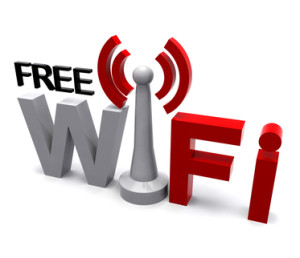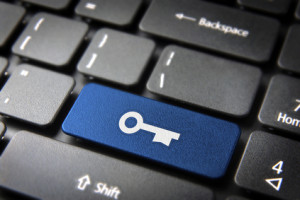 Public Wifi is available in many of our favourite coffee shops and restaurants. You may be greeted with a sign, “Free WiFi”. That is a convenient service that lets us check our email or surf the web while we eat or have a drink. But what surfing can you safely do there?
Public Wifi is available in many of our favourite coffee shops and restaurants. You may be greeted with a sign, “Free WiFi”. That is a convenient service that lets us check our email or surf the web while we eat or have a drink. But what surfing can you safely do there?
In most cases there is no security key required. This means that the Public Wifi is really public; anyone could be hooked up to the same network as you are. Is the fellow in the corner waiting for you to pass along some info that he would like to use? If we don’t have to log in or enter a security key, we should be very careful about our surfing habits. If we just go to a website, like google.com, or cbc.ca, we aren’t at risk, because we are not sending private information. But if we log into a site, whether it be to bank online or log into our Facebook page, we need to protect ourselves. How do we do that?
Public Wifi – Network type
When you first get onto a public wifi network, you will likely be prompted by your firewall program to choose the type of network you are on. The choices may be “Public”, “Home”, “Work” or other choices. Choosing “Public” will let your firewall give you the greatest protection from unauthorized access to your computer. The fact that you may be doing work doesn’t matter; the safest setting is “Public”.
Public Wifi – Secure sites
If logging on to a site, like a bank, be sure you are on an encrypted site. Make sure that https appears in the address bar. As you go from page to page within the site, keep checking to see that the address is https. If it isn’t, log out right away. This can happen if you are on a secure site and access a site that is advertised, perhaps as a banner ad, that you wish to see. It would be best to finish your activity on the secured site, and then log out before going to other sites.
Make sure you log out of the site when you are done. Don’t just close your browser or that page and assume that you are logged out. If you just close the page, or have multiple instances of the browser open, it is possible to reopen the secure page without re-entering you username and password. Try this at home, and see how your browser reacts.
Restrict your secured browsing to sites that you know. An unfamiliar site can still mock-up the https so that you think you are safe. If you already know the site, like your bank, you will probably be alright.
Don’t use the same password for all sites. Passwords for sites that have sensitive information, should have a password separate password. Think about it this way. If someone obtained your password, would they get access to your bank account, as well as some other less important site?
Public Wifi – Malicious sites
If you are alerted to a fraudulent website or that you may be trying to download a malicious program, heed the warning and don’t continue. While that is good practise at home as well, the guy in the corner at the coffee shop may have set up the malicious code to get into your info.
Public Wifi – Passwords and Firewalls
If a Wi-Fi network uses encryption, take note of which one it is. WEP is common, and the key may be supplied by staff where you are. WEP can be easily breached by common hacking programs, and should be treated the same as an unsecured network. WPA and WPA2 are much more secure, but caution should always be used.
Be sure that your firewall and anti-virus are all up to date, and don’t disable any protection just to look at a site. Be sure no one is looking over your shoulder as youtype in your username and password, or allow a stranger to use your equipment.